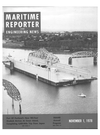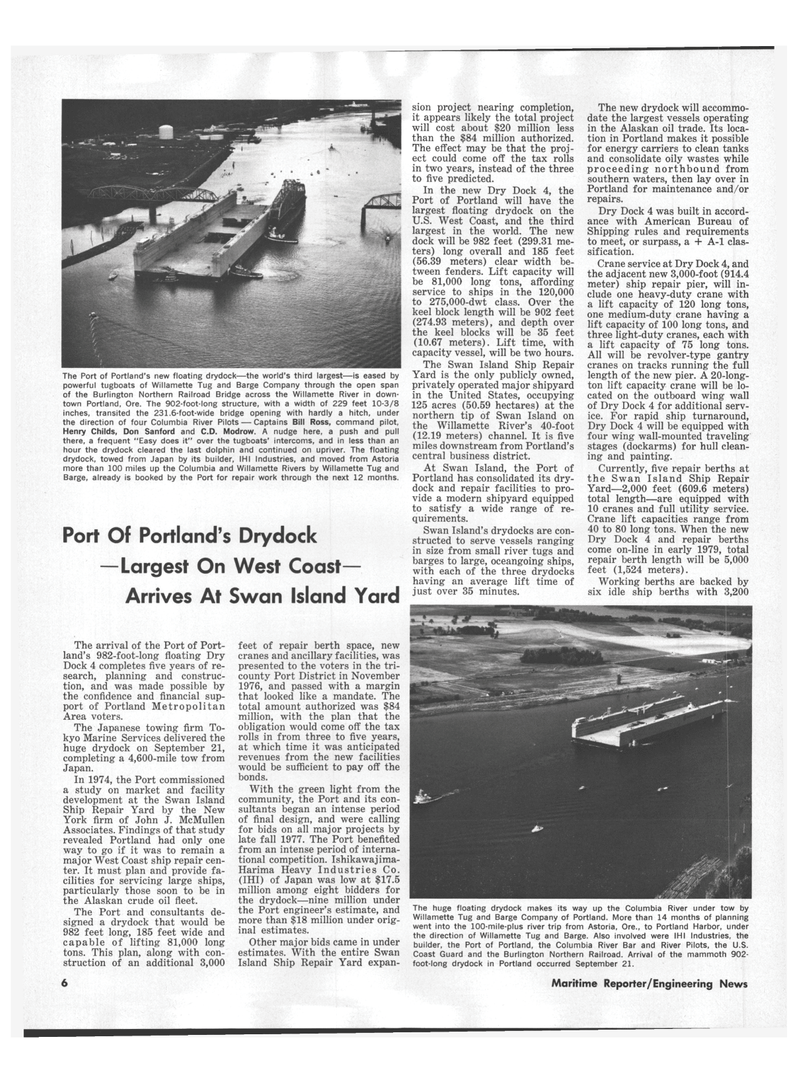
Page 6: of Maritime Reporter Magazine (November 1978)
Read this page in Pdf, Flash or Html5 edition of November 1978 Maritime Reporter Magazine
The Port of Portland's new floating drydock—the world's third largest—is eased by powerful tugboats of Willamette Tug and Barge Company through the open span of the Burlington Northern Railroad Bridge across the Willamette River in down- town Portland, Ore. The 902-foot-long structure, with a width of 229 feet 10-3/8 inches, transited the 231.6-foot-wide bridge opening with hardly a hitch, under the direction of four Columbia River Pilots — Captains Bill Ross, command pilot,
Henry Childs, Don Sanford and C.D. Modrow. A nudge here, a push and pull there, a frequent "Easy does it" over the tugboats' intercoms, and in less than an hour the drydock cleared the last dolphin and continued on upriver. The floating drydock, towed from Japan by its builder, IHI Industries, and moved from Astoria more than 100 miles up the Columbia and Willamette Rivers by Willamette Tug and
Barge, already is booked by the Port for repair work through the next 12 months.
Port Of Portland's Drydock —Largest On West Coast—
Arrives At Swan Island Yard
The arrival of the Port of Port- land's 982-foot-long floating Dry-
Dock 4 completes five years of re- search, planning and construc- tion, and was made possible by the confidence and financial sup- port of Portland Metropolitan
Area voters.
The Japanese towing firm To- kyo Marine Services delivered the huge drydock on September 21, completing a 4,600-mile tow from
Japan.
In 1974, the Port commissioned a study on market and facility development at the Swan Island
Ship Repair Yard by the New
York firm of John J. McMullen
Associates. Findings of that study revealed Portland had only one way to go if it was to remain a major West Coast ship repair cen- ter. It must plan and provide fa- cilities for servicing large ships, particularly those soon to be in the Alaskan crude oil fleet.
The Port and consultants de- signed a drydock that would be 982 feet long, 185 feet wide and capable of lifting 81,000 long tons. This plan, along with con- struction of an additional 3,000 feet of repair berth space, new cranes and ancillary facilities, was presented to the voters in the tri- county Port District in November 1976, and passed with a margin that looked like a mandate. The total amount authorized was $84 million, with the plan that the obligation would come off the tax rolls in from three to five years, at which time it was anticipated revenues from the new facilities would be sufficient to pay off the bonds.
With the green light from the community, the Port and its con- sultants began an intense period of final design, and were calling for bids on all major projects by late fall 1977. The Port benefited from an intense period of interna- tional competition. Ishikawajima-
Harima Heavy Industries Co. (IHI) of Japan was low at $17.5 million among eight bidders for the drydock—nine million under the Port engineer's estimate, and more than $18 million under orig- inal estimates.
Other major bids came in under estimates. With the entire Swan
Island Ship Repair Yard expan- sion project nearing completion, it appears likely the total project will cost about $20 million less than the $84 million authorized.
The effect may be that the proj- ect could come off the tax rolls in two years, instead of the three to five predicted.
In the new Dry Dock 4, the
Port of Portland will have the largest floating drydock on the
U.S. West Coast, and the third largest in the world. The new dock will be 982 feet (299.31 me- ters) long overall and 185 feet (56.39 meters) clear width be- tween fenders. Lift capacity will be 81,000 long tons, affording service to ships in the 120,000 to 275,000-dwt class. Over the keel block length will be 902 feet (274.93 meters), and depth over the keel blocks will be 35 feet (10.67 meters). Lift time, with capacity vessel, will be two hours.
The Swan Island Ship Repair
Yard is the only publicly owned, privately operated major shipyard in the United States, occupying 125 acres (50.59 hectares) at the northern tip of Swan Island on the Willamette River's 40-foot (12.19 meters) channel. It is five miles downstream from Portland's central business district.
At Swan Island, the Port of
Portland has consolidated its dry- dock and repair facilities to pro- vide a modern shipyard equipped to satisfy a wide range of re- quirements.
Swan Island's drydocks are con- structed to serve vessels ranging in size from small river tugs and barges to large, oceangoing ships, with each of the three drydocks having an average lift time of just over 35 minutes.
The new drydock will accommo- date the largest vessels operating in the Alaskan oil trade. Its loca- tion in Portland makes it possible for energy carriers to clean tanks and consolidate oily wastes while proceeding northbound from southern waters, then lay over in
Portland for maintenance and/or repairs.
Dry Dock 4 was built in accord- ance with American Bureau of
Shipping rules and requirements to meet, or surpass, a + A-l clas- sification.
Crane service at Dry Dock 4, and the adjacent new 3,000-foot (914.4 meter) ship repair pier, will in- clude one heavy-duty crane with a lift capacity of 120 long tons, one medium-duty crane having a lift capacity of 100 long tons, and three light-duty cranes, each with a lift capacity of 75 long tons.
All will be revolver-type gantry cranes on tracks running the full length of the new pier. A 20-long- ton lift capacity crane will be lo- cated on the outboard wing wall of Dry Dock 4 for additional serv- ice. For rapid ship turnaround,
Dry Dock 4 will be equipped with four wing wall-mounted traveling stages (dockarms) for hull clean- ing and painting.
Currently, five repair berths at the Swan Island Ship Repair
Yard—2,000 feet (609.6 meters) total length—are equipped with 10 cranes and full utility service.
Crane lift capacities range from 40 to 80 long tons. When the new
Dry Dock 4 and repair berths come on-line in early 1979, total repair berth length will be 5,000 feet (1,524 meters).
Working berths are backed by six idle ship berths with 3,200
The huge floating drydock makes its way up the Columbia River under tow by
Willamette Tug and Barge Company of Portland. More than 14 months of planning went into the 100-mile-plus river trip from Astoria, Ore., to Portland Harbor, under the direction of Willamette Tug and Barge. Also involved were IHI Industries, the builder, the Port of Portland, the Columbia River Bar and River Pilots, the U.S.
Coast Guard and the Burlington Northern Railroad. Arrival of the mammoth 902- foot-long drydock in Portland occurred September 21. 12 Maritime Reporter/Engineering News

 5
5

 7
7
